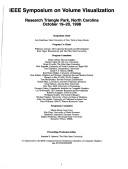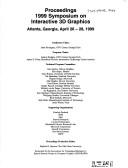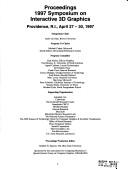| Listing 1 - 9 of 9 |
Sort by
|

ISBN: 1581131054 0818691808 0818691816 0818691824 9780818691812 9781581131055 9780818691829 9780818691805 Year: 1998 Publisher: IEEE
Abstract | Keywords | Export | Availability | Bookmark
 Loading...
Loading...Choose an application
- Reference Manager
- EndNote
- RefWorks (Direct export to RefWorks)

ISBN: 0897918657 0780337093 9780780337091 9780897918657 Year: 1996 Publisher: IEEE
Abstract | Keywords | Export | Availability | Bookmark
 Loading...
Loading...Choose an application
- Reference Manager
- EndNote
- RefWorks (Direct export to RefWorks)
Book

ISBN: 0897914678 0897914716 9780897914673 9780897914710 Year: 1992 Publisher: ACM
Abstract | Keywords | Export | Availability | Bookmark
 Loading...
Loading...Choose an application
- Reference Manager
- EndNote
- RefWorks (Direct export to RefWorks)

ISBN: 1581130821 9781581130829 Year: 1999 Publisher: ACM
Abstract | Keywords | Export | Availability | Bookmark
 Loading...
Loading...Choose an application
- Reference Manager
- EndNote
- RefWorks (Direct export to RefWorks)

ISBN: 0897918843 9780897918848 Year: 1997 Publisher: ACM
Abstract | Keywords | Export | Availability | Bookmark
 Loading...
Loading...Choose an application
- Reference Manager
- EndNote
- RefWorks (Direct export to RefWorks)

ISBN: 0792315502 9401051283 9401125562 9780792315506 Year: 1992 Volume: 354 Publisher: Dordrecht ; Norwell, MA : Kluwer,
Abstract | Keywords | Export | Availability | Bookmark
 Loading...
Loading...Choose an application
- Reference Manager
- EndNote
- RefWorks (Direct export to RefWorks)
Information storage and retrieval systems --- Geological modeling --- Three-dimensional display systems --- Geology --- Congresses. --- Mines and mineral resources --- Information storage and retrieval systems - Geology - Congresses. --- Information storage and retrieval systems - Mines and mineral resources - Congresses. --- Geological modeling - Congresses. --- Three-dimensional display systems - Congresses.
Book
ISBN: 0444879013 0444600221 1299282512 9780444879011 9781299282513 9780444600226 Year: 1986 Volume: 3 Publisher: Amsterdam New York New York, N.Y., U.S.A. North-Holland Sole distributors for the U.S.A. and Canada, Elsevier Science Pub. Co.
Abstract | Keywords | Export | Availability | Bookmark
 Loading...
Loading...Choose an application
- Reference Manager
- EndNote
- RefWorks (Direct export to RefWorks)
Techniques for 3-D Machine Perception
Computer vision --- Three-dimensional display systems --- Congresses --- -Three-dimensional display systems --- -3-D display systems --- 3D display systems --- Display systems, Three-dimensional --- Information display systems --- Three-dimensional imaging --- Machine vision --- Vision, Computer --- Artificial intelligence --- Image processing --- Pattern recognition systems --- Congresses. --- -Congresses --- Monograph --- Computer vision - Congresses --- Three-dimensional display systems - Congresses
Book
ISBN: 3540873945 3642099513 9786611875718 1281875716 3540873953 Year: 2009 Publisher: Berlin, Heidelberg : Springer Berlin Heidelberg : Imprint: Springer,
Abstract | Keywords | Export | Availability | Bookmark
 Loading...
Loading...Choose an application
- Reference Manager
- EndNote
- RefWorks (Direct export to RefWorks)
In recent years 3D geo-information has become an important research area due to the increased complexity of tasks in many geo-scientific applications, such as sustainable urban planning and development, civil engineering, risk and disaster management and environmental monitoring. Moreover, a paradigm of cross-application merging and integrating of 3D data is observed. The problems and challenges facing today’s 3D software, generally application-oriented, focus almost exclusively on 3D data transportability issues – the ability to use data originally developed in one modelling/visualisation system in other and vice versa. Tools for elaborated 3D analysis, simulation and prediction are either missing or, when available, dedicated to specific tasks. In order to respond to this increased demand, a new type of system has to be developed. A fully developed 3D geo-information system should be able to manage 3D geometry and topology, to integrate 3D geometry and thematic information, to analyze both spatial and topological relationships, and to present the data in a suitable form. In addition to the simple geometry types like point line and polygon, a large variety of parametric representations, freeform curves and surfaces or sweep shapes have to be supported. Approaches for seamless conversion between 3D raster and 3D vector representations should be available, they should allow analysis of a representation most suitable for a specific application.
Geographic information systems --Congresses. --- Three-dimensional display systems --Congresses. --- Geographic information systems --- Three-dimensional display systems --- Geography --- Earth & Environmental Sciences --- Geography-General --- Cartography --- Geography. --- Computer graphics. --- Geographical information systems. --- Geographical Information Systems/Cartography. --- Computer Imaging, Vision, Pattern Recognition and Graphics. --- Computer vision. --- Machine vision --- Vision, Computer --- Artificial intelligence --- Image processing --- Pattern recognition systems --- Geographical information systems --- GIS (Information systems) --- Information storage and retrieval systems --- Optical data processing. --- Optical computing --- Visual data processing --- Bionics --- Electronic data processing --- Integrated optics --- Photonics --- Computers --- Optical equipment
Book
ISBN: 184882811X 9786613082312 1848828128 1283082314 Year: 2010 Publisher: London ; New York : Springer,
Abstract | Keywords | Export | Availability | Bookmark
 Loading...
Loading...Choose an application
- Reference Manager
- EndNote
- RefWorks (Direct export to RefWorks)
The field of sketch-based interfaces and modeling (SBIM) focuses on developing methods and techniques to enable users to interact with a computer through sketching - a simple, yet highly expressive medium. SBIM blends concepts from computer graphics, human-computer interaction, artificial intelligence, and machine learning. Recent improvements in hardware, coupled with new machine learning techniques for more accurate recognition, and more robust depth inferencing techniques for sketch-based modeling, have resulted in an explosion of both sketch-based interfaces and pen-based computing devices. Presenting the first coherent, unified overview of SBIM, this unique text/reference bridges the two complementary research areas of user interaction (sketch-based interfaces), and graphical modeling and construction (sketch-based modeling). The book discusses the state of the art of this rapidly evolving field, with contributions from an international selection of experts. Also covered are sketch-based systems that allow the user to manipulate and edit existing data - from text, images, 3D shapes, and video - as opposed to modeling from scratch. Topics and features: Reviews pen/stylus interfaces to graphical applications that avoid reliance on user interface modes Describes systems for diagrammatic sketch recognition, mathematical sketching, and sketch-based retrieval of vector drawings Examines pen-based user interfaces for engineering and educational applications Presents a set of techniques for sketch recognition that rely strictly on spatial information Introduces the Teddy system; a pioneering sketching interface for designing free-form 3D models Investigates a range of advanced sketch-based systems for modeling and designing 3D objects, including complex contours, clothing, and hair-styles Explores methods for modeling from just a single sketch or using only a few strokes This text is an essential resource for researchers, practitioners and graduate students involved in human-factors and user interfaces, interactive computer graphics, and intelligent user interfaces and AI. Dr. Joaquim Jorge is a professor at the Computer Science and Engineering Department (DEI) of the School of Engineering (IST) at the Technical University of Lisbon, Portugal. Dr. Faramarz Samavati is an associate professor at the Department of Computer Science at the University of Calgary, Canada.
Computer graphics -- Congresses. --- Computer-aided design -- Congresses. --- Image processing -- Digital techniques -- Congresses. --- Three-dimensional display systems -- Congresses. --- User interfaces (Computer systems) -- Congresses. --- User interfaces (Computer systems) --- Model-integrated computing --- Computer simulation --- Engineering & Applied Sciences --- Electrical & Computer Engineering --- Applied Physics --- Electrical Engineering --- Technology - General --- Computer Science --- Computer interfaces. --- Computer-aided design. --- CAD (Computer-aided design) --- Computer-assisted design --- Interfaces, Computer --- Computer science. --- User interfaces (Computer systems). --- Computer graphics. --- Computer Science. --- Computer Imaging, Vision, Pattern Recognition and Graphics. --- User Interfaces and Human Computer Interaction. --- Computer-aided engineering --- Design --- Computer input-output equipment --- Interface circuits
| Listing 1 - 9 of 9 |
Sort by
|

 Search
Search Feedback
Feedback About
About Help
Help News
News